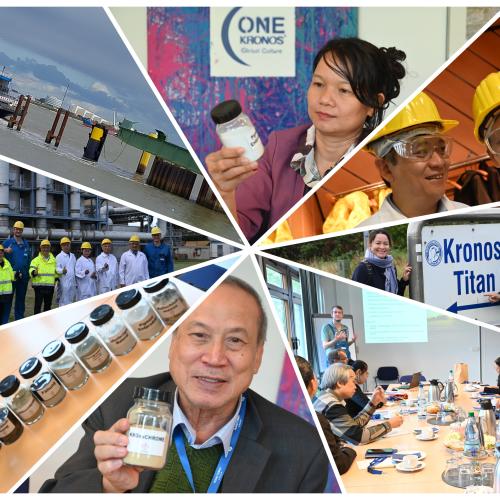Good health and well-being
Responsible consumption and production
Climate action
Project coordinator:
Hochschule Magdeburg-Stendal
FB Wasser, Umwelt, Bau und Sicherheit
Breitscheidstraße 2
39114 Magdeburg
Contact person:
Prof. Dr. Petra Schneider
Phone: +49 (0)391 886 4577
Email: petra.schneider(at)h2.de
Conrad Dorer
E-Mail: conrad.dorer(at)h2.de
Project partner:
- G.E.O.S Ingenieurgesellschaft mbH / WISUTEC GmbH;
- IAF Radioökologie GmbH;
- Vietnam Atomic Energy Institute, Institute of Nuclear Science and Technology (INST);
- Industrial University of Ho Chi Minh City (IUH);
- Institute of Public Health
Utilisation of NORM residues from the titanium industry in Vietnam
Minerals containing titanium are used in the production of white piments and specialist products ranging from medicines to aerospace technology. These minerals often originate from heavy mineral sands, which are enriched with natural radioactive substances during extraction. The CLIENT II project RENO-TITAN is investigating the framework conditions as well as technological and management-based methods for the sustainable and hazard-free utilisation of residues from the titanium industry in Vietnam. The aim is to make the Vietnamese titanium industry sustainable in the medium term and ensure its future viability.
Titanium mining: Opportunities and risks for Vietnam
Titanium is a strong, lightweight and corrosion-resistant metal used in the aerospace and shipbuilding industries, as well as in desalination plants. Although titanium is the ninth most common element in the Earth’s crust, there are only a few countries in the world with large deposits. One of these countries is Vietnam. In Vietnam, titanium-rich mineral sands, such as ilmenite, are found in coastal sands, dunes and in the sandy soil of coastal forests. However, the mining of these sands leads to conflicts over land use and has a negative impact on the environment. Washing out the heavy mineral sands consumes large quantities of groundwater and pollutes it. Agriculture and other important sectors then lack this wa-ter. The falling groundwater level also allows seawater to penetrate deeper into coastal areas, which exacerbates these issues further. Some Vietnamese provinces are also having to contend with an increasing drought trend, which further worsens the situation. Another problem the RENO-TITAN project team is focu-sing on is the accumulation of natural radioactive sub-stances in the residues from the mining process. These NORM (naturally occurring radioactive materials) are hardly known and therefore insufficiently regulated in Vi-etnam. Residues are currently often stored without any kind of monitoring and therefore pose a risk to humans and the environment.

How can technological and management measures reduce the negative impact on humans and the environment during the extraction and processing of titanium-bearing minerals? What sustainable and therefore economically attractive utilisation options are there for NORM waste from mining in Vietnam? What precautionary measures are required under occupational health and safety law when dealing with NORM residues in order to ensure safe utilisation in terms of health and safety law? These questions are the focus of the joint project.
On ore and streaks: Putting titanium residues to the test
The RENO-TITAN project partners are taking a three-pronged approach to improve the utilisation and safe disposal of NORM waste:
(1) Firstly, they are aiming to help create the basis for a regulatory framework. This involves both national guidelines for the handling of these materials and, at an operational level, regulations to ensure the quality and comparability of radiological measurements in laboratories.
(2) Secondly, they are carrying out extensive environmental assessments on current titanium extraction in Vietnam. These analyses also include environmental and economic assessments to find the most sustainable options for the use and disposal of NORM residues. The team will closely coordinate with the Vietnamese authorities in Binh Thuan province on the results.
(3) The third focus is on developing technical processes for safe disposal. Laboratory tests and close cooperation between German and Vietnamese research institutions are planned to find materials that can allow for the long-term storage of NORM residues.

From waste to resource: Radioactive residues as substitute building materials?
SAND!, the project’s predecessor under the CLIENT II funding programme, dealt with the sand shortage in Southeast Asia and the increasing extraction of sand from sensitive ecosystems such as the Mekong Delta. Alternative building materials made from mining residues could offer a promising situation to reduce the pressure on these natural resources.
The RENO-TITAN project expands on this approach. In addition to clean production, occupational safety and the environmentally friendly disposal of hazardous waste, the focus is also on the reuse of residues in to strengthen the circular economy. By utilising such materials, waste from titanium extraction could be reused sensibly and mining activities could be made more sustainable. This provides Vietnamese partners with practical knowledge and skills for operational implementation. The example of titanium extraction can therefore be used to show how industrial processes can be designed sustainably to also protect the environment.
RENO-TITAN: NORM in focus - knowledge transfer from Germany to Vietnam

RENO-TITAN: With the scintillator through the titanium mine

